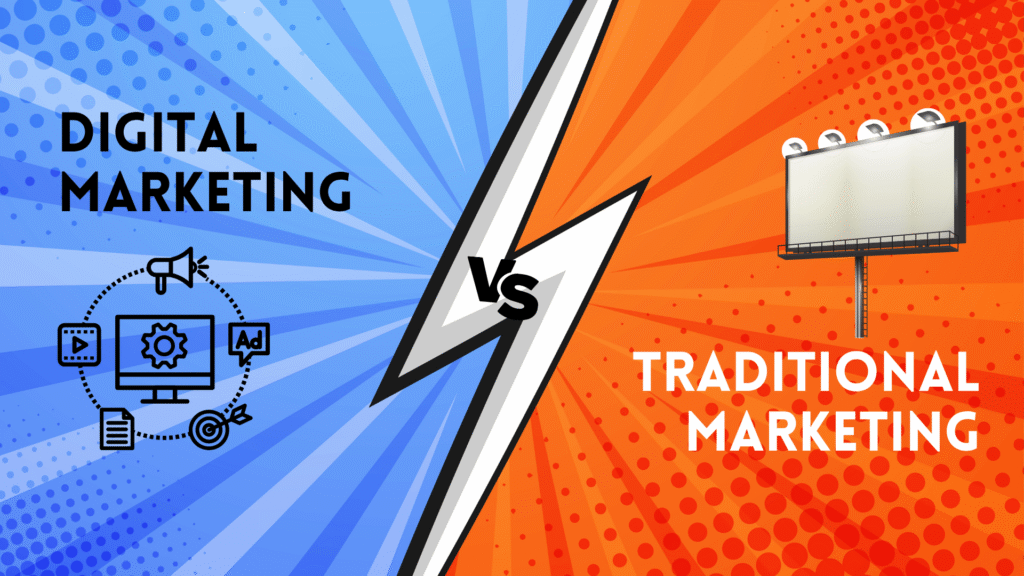In a world that’s rapidly going digital, businesses are often caught between two powerful strategies: digital marketing and traditional marketing. While both aim to attract, engage, and convert customers, the way they do it is completely different.
So, which is better? The answer depends on your goals, audience, and budget.
In this blog, we’ll explore the key differences, pros and cons, and when to use digital or traditional marketing to grow your business in 2025 and beyond.
What is Traditional Marketing?
Traditional marketing refers to the conventional methods of advertising that have been around for decades. These include:
- TV and radio ads
- Newspaper and magazine ads
- Billboards and posters
- Flyers and brochures
- Telemarketing and direct mail
These methods focus on reaching a broad audience through offline channels and often require a bigger budget for production and distribution.
What is Digital Marketing?
Digital marketing uses the internet and electronic devices to promote products or services. It includes:
- Social media marketing (Facebook, Instagram, LinkedIn)
- Search engine optimization (SEO)
- Pay-per-click (PPC) advertising (Google Ads)
- Email marketing
- Content marketing (blogs, videos, infographics)
- Influencer marketing
Digital marketing is data-driven, highly targeted, and more interactive compared to traditional marketing.

Digital Marketing vs Traditional Marketing: A Quick Comparison
| Feature | Traditional Marketing | Digital Marketing |
|---|---|---|
| Reach | Local or mass offline audience | Global and targeted online audience |
| Cost | High production and media costs | Budget-friendly, scalable campaigns |
| Interactivity | One-way communication | Two-way engagement (comments, shares) |
| Results Tracking | Difficult to measure | Real-time analytics and insights |
| Flexibility | Fixed once launched | Easily adjustable, A/B testing friendly |
| Speed | Slower to execute | Instant publishing and response |
| Personalization | Limited | Highly personalized (email, retargeting) |
Pros of Digital Marketing
- Cost-effective: Ideal for small to medium businesses with limited budgets
- Measurable results: Track clicks, conversions, and ROI in real time
- Precise targeting: Reach users based on age, location, interest, and behavior
- High engagement: Engage with your audience through comments, likes, and shares
- 24/7 visibility: Your ads, blogs, or videos work for you round the clock
Cons of Digital Marketing
- Information overload: Users are bombarded with ads, making it harder to stand out
- Ad blockers: Many users use tools that block digital ads
- Requires constant updates: Algorithms change frequently, requiring strategy shifts
- Takes time to build trust: SEO and content marketing are long-term games
- Technical skills needed: Managing platforms, analytics, and tools can be complex without expertise
Pros of Traditional Marketing
- Mass exposure: TV and billboards can reach thousands instantly
- Credibility: Print ads and television are often seen as more “trustworthy”
- Local impact: Great for community-focused or location-specific campaigns
- Tangible experience: Flyers, brochures, and product samples can leave a lasting impression
- Less digital fatigue: No screens involved—can be refreshing for some audiences
Cons of Traditional Marketing
- High cost: Printing, production, and media placement can be expensive
- Difficult to measure: ROI tracking is often unclear or delayed
- Limited targeting: Broad reach may miss your actual target audience
- One-way communication: No real-time engagement with customers
- Longer execution time: Planning and publishing take significantly more time
So, Which One Should You Choose?
The right marketing strategy depends on your:
- Target audience
- Budget
- Business type
- Marketing goals
👉 If you want brand visibility and reach older demographics, traditional marketing might work well.
👉 But if your audience is online, mobile-first, and research-oriented, digital marketing is a must.
👉 For most businesses today, the best approach is a smart blend of both — a strategy known as integrated marketing.
Real-World Example
Let’s say you own a restaurant:
- Traditional marketing would involve flyers, local radio ads, or newspaper listings.
- Digital marketing could include Instagram ads, Google Maps listings, and influencer reviews.
Using both helps you maximize reach and diversify your brand presence.
Final Thoughts
In 2025, digital marketing isn’t just an option — it’s a necessity. However, traditional marketing still holds power when used strategically.
The best results come from knowing where your customers are and meeting them with the right message at the right time — whether that’s on a billboard or inside their Instagram feed.
